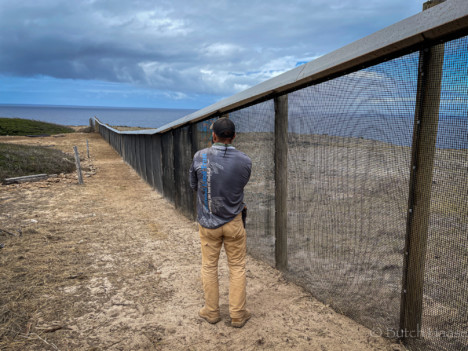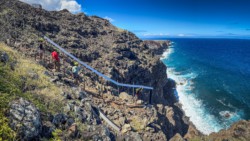Promising Signs for Native Species Recovery in Mokio
Wedged between ‘Ilio Point and Mo’omomi, the Mokio Preserve has been a focal point for native species rehabilitation for years. Now, with the completion of a state-of-the-art predator proof fence, the preserve is poised to support a resurgence of native plants and birds.
Construction of the 5,600-foot-long conservation fence began back in August 2020 as a joint project between the Molokai Land Trust and American Bird Conservancy (ABC).
“We’ve already begun seeing benefits from the newly installed fence, including Wedge-tailed Shearwater (‘Ua’u Kani) chicks this year, compared to previous years when all chicks were lost to mongoose predation,” explained Bard Keitt, oceans and islands director at ABC.
The fence is “more robust” than the deer fence which previously protected the Mokio Preserve, said Keitt. This new fence has a stainless-steel hood, which stops mongooses, cats and deer from surmounting it. It also has a tight mesh and underground skirt which prevents animals like rats and mice from burrowing underneath.
The predator proof fence, which is the first of its kind on Molokai, is particularly effective at protecting seabird ground nesting habitats.
“Seabirds are the most endangered group of birds and restoring their populations on Molokai has been a long-term goal of the Mokio restoration partnership,” said Keitt. “Through social attraction and active translocation methods, we hope to establish species that are losing their nesting sites due to sea level rise in the Northwest Hawaiian Islands, such as Laysan and Black-footed Albatrosses, Bonin Petrels (Nunulu), and Tristram’s Storm-Petrels (Akihikeʻehiʻale).”
Before it became a preserve, the area was used as ranch land. Over the years, cattle, goats and deer spread non-native grasses and kiawe along the site. Now, the hope is that native plants will be able to populate across the ecosystem.
“Mokio is a special place and it has been phenomenal to see the transformation from a degraded area to thriving native coastal strand habitat with blooming native species carpeting the ground,” said Butch Haase, executive director of the Molokai Land Trust, who has been leading the effort to protect the site since 2009. “It is now possible to stand in the middle of the project and see only native species and ocean, giving people a chance to experience what Hawaii used to be like. It is our hope that seeing this restored land will inspire others to do the same elsewhere across our islands.”
Rehabilitation work in the Mokio Preserve has already led to promising results.
“Restoration activities also include wildlife components, and part of this effort includes trapping of predators like cats, rats and mongoose to allow for ground nesting seabirds to recolonize the area,” explained Haase. “In 2020 we had our first successful Wedge-tailed Shearwater chicks born and fledged. We saw a 450 percent increase in fledged chicks last year over the first year and are expecting the largest number yet this fall when the current breeding season wraps up in November.”
The Mokio Preserve will still be accessible for Molokai community members via gates in the fence. However, Haase explained that closing these vehicle and pedestrian gates is critical to maintaining the integrity of the site.
There are no new regulations for fishing, hunting or gathering in the Mokio Preserve, and passes for such activities are free for residents. The Molokai Land Trust will be creating a new, online reservation system for the 2025 season.
Learn more about the Mokio Preserve at molokailandtrust.org/the-mokio-preserve.













Don't have a Molokai Dispatch ID?
Sign up is easy. Sign up now
You must login to post a comment.
Lost Password